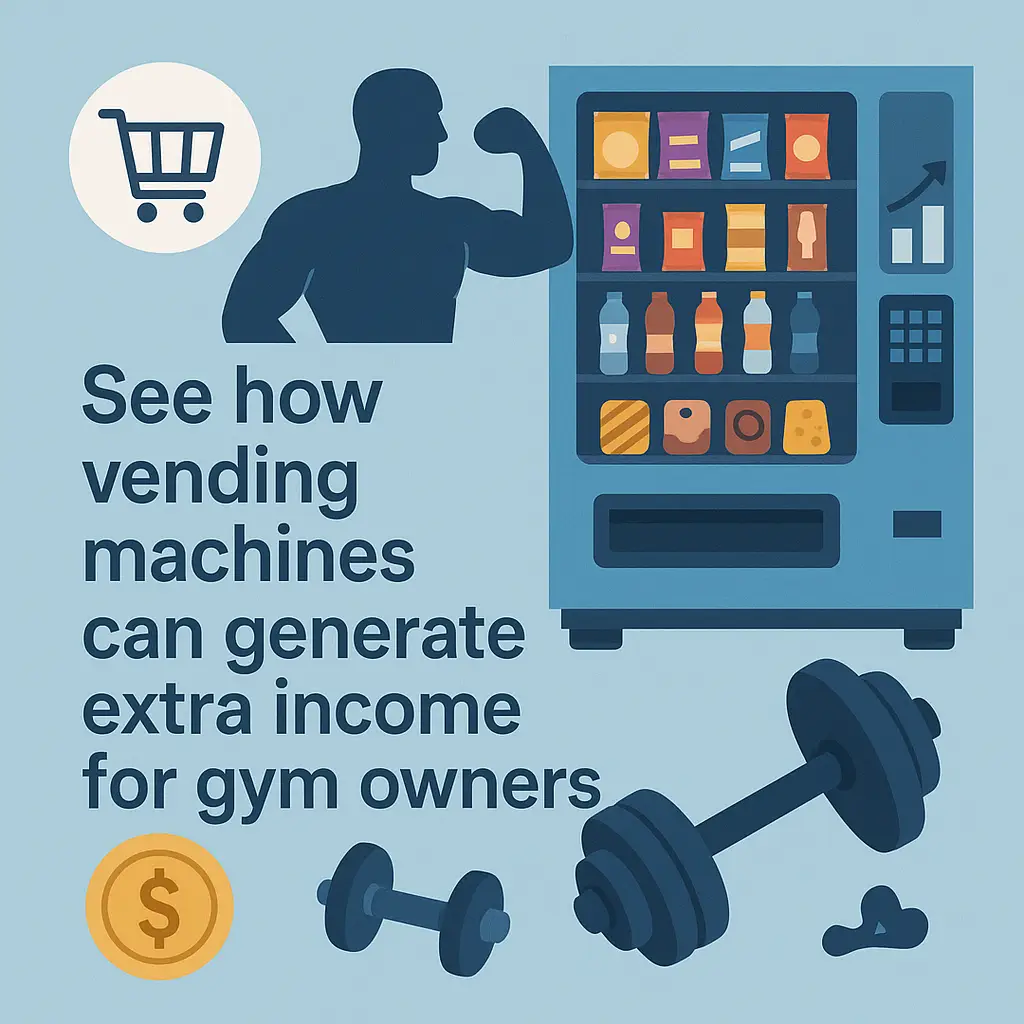How Gym Owners Profit from Vending Machines
See how vending machines can generate extra income for gym owners through commissions and increased member spending.
Back to Vending for Gyms ResourcesSee how vending machines can generate extra income for gym owners through commissions and increased member spending.
Back to Vending for Gyms ResourcesProfits vary, but gyms often earn commissions based on sales volume, ranging from modest monthly income to thousands per year depending on location and member traffic.
![]() Vending commissions add steady income with minimal effort
Vending commissions add steady income with minimal effort
![]() Product variety drives higher member spending per visit
Product variety drives higher member spending per visit
![]() Strategic placement boosts visibility and overall profit potential
Strategic placement boosts visibility and overall profit potential

Adding vending machines to a fitness center has become an increasingly common way for gym owners to generate passive revenue. These machines not only provide members with convenient access to drinks and snacks but also create a reliable income stream for the business.
Most gyms earn profit through commissions on product sales. Each purchase made by a member contributes a percentage back to the facility, typically ranging from a small portion per transaction to a steady monthly payout. The exact amount depends on traffic volume, product mix, and pricing strategy. With consistent member usage, vending can create a meaningful financial boost over time.
One of the main benefits of gym vending machines is their ability to encourage additional purchases. Members who might not leave the gym for a quick snack are more likely to grab an energy drink, protein bar, or bottle of water if it is available on-site. By curating items that align with workout routines, owners can increase average spending per visit and add to overall revenue.
Profitability also depends on where the machines are installed. High-traffic areas such as entrances, locker rooms, and waiting areas provide greater visibility and accessibility. A well-placed machine can significantly outperform one hidden away from daily foot traffic. For more placement guidance, see resources on strategic machine locations.
Modern machines offer more than just standard snacks and drinks. Options like glass-front coolers and smart vending systems allow for better product tracking and more appealing displays. These upgrades can increase member engagement and ensure machines stay stocked with what people want most. To explore technology differences, review insights on popular machine types.
Profit will vary based on member size, hours of operation, and sales consistency. While some gyms see modest monthly income, others generate thousands annually, especially when traffic is high and products are carefully chosen. If the machines are well-managed, they can offer a consistent revenue stream with minimal overhead. For gyms open around the clock, additional details can be found in guides on supporting 24-hour operations.
If you're exploring vending options for your business, Vending Exchange can help simplify the process. Delivery, Installation and Equipment is provided at no cost to you - vendors provide the machines, keep them stocked, and handle all servicing. Whether you need a provider or full-service management, just fill out the form on this page to get started.
Hospitals and clinics rely on vending for quick, convenient options. Without strong agreements, facilities may face broken machines, expired products, or delays in servicing. A well-structured contract ensures consistent quality while outlining responsibilities for both sides.
One of the most important elements is defining who is responsible for regular maintenance and repair. Healthcare settings demand reliable machines, so contracts should clearly state expected response times for repairs and how preventive servicing will be handled.
Healthcare environments often require nutritious and compliant product offerings. Contracts should specify healthy snack options, allergen labeling, and dietary accommodations. Clear product requirements protect facilities from stocking items that conflict with wellness goals.
Many vending contracts include commissions or flat fees. Healthcare facilities should review these terms carefully to understand how revenue is calculated, how payments are distributed, and whether these terms align with organizational goals. More details about financial arrangements can be found in resources like nursing home vending agreements.
Today’s healthcare vending services often include contactless payments, mobile wallets, and smart vending tech. Contracts should confirm whether these technologies are included, as they improve hygiene and accessibility for both patients and staff. For further insight, see how touchless vending in hospitals addresses hygiene concerns.
Finally, contracts should address flexibility. Facilities may grow, change, or require different machine types over time. Exit clauses protect hospitals and clinics from long-term commitments that no longer fit their needs.
If you're exploring vending options for your business, Vending Exchange can help simplify the process. Delivery, Installation and Equipment is provided at no cost to you - vendors provide the machines, keep them stocked, and handle all servicing. Whether you need a provider or full-service management, just fill out the form on this page to get started.
Gyms typically earn commissions from each product sold, providing a steady revenue stream with little additional effort.
Rates vary, but gyms often receive a percentage of sales, which can add up to significant monthly income depending on traffic.
Yes, revenue is tied to member volume, so smaller gyms often see modest profits compared to larger facilities.
In most cases, the added income offsets space usage, especially in high-traffic areas.
Items like energy drinks, protein bars, and bottled water usually sell the fastest and generate reliable profit.
No, machines are typically stocked and serviced by the operators, requiring little involvement from gym staff.
Yes, revenue tends to be consistent across the year, though sales may spike during peak fitness seasons like New Year or summer.
Yes, round-the-clock availability often increases sales since members can purchase at any hour.
Many gyms begin seeing returns immediately, with profit growing steadily as member usage increases.
Absolutely—choosing high-demand items tailored to fitness needs can greatly improve sales performance and profit margins.